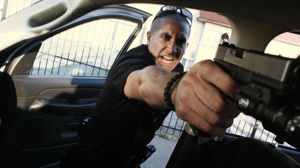For the first few minutes of End of Watch, you managed some good undercover work. A camera strapped to the dashboard of a police cruiser makes a high-speed chase impressively compelling. The danger felt authentic in a way few buddy-cop movies ever do. But then you disobeyed the orders of the found footage genre, perfectly happy to operate without rhyme or reason for the rest of the movie. Normally I'm not so forgiving about these types of artistic infractions. But there were enough redeemable qualities in David Ayer's latest L.A.P.D. ride-along that I'm going to let you off the hook.
Jake Gyllenhaal plays Brian Taylor, a beat cop who is constantly shooting himself with a camera (for a film class, we're told) when he's not shooting bad guys. He clips a recording device to himself and partner Mike Zavala's (Michael Peña), and away we go. Early on, every shot is motivated and explained. You even managed that immersive trick of the actor pointing the camera at a mirror to have the audience believe your services weren't even needed. Then maybe you got jealous that Gyllenhaal would actually take the credit, because, for the rest of the film, you were all over the place.
The story is all over the place, too, taking an episodic approach that doesn't stick with any one single case that needs to be solved. The two officers (and your omnipresent crew) race from call-to-random-call, and, during this time, I was won over by the chemistry between the partners. Taylor longs for a meaningful relationship, which he thinks he's found in Janet (Anna Kendrick), while Pena expels the virtues of having a big Mexican family. The first half of the film is filled with moments that endear us to both the profession and the people involved.
The slow build, however, means the climactic events that follow, and the motivations that incite them, come a bit too late (though they do carry an impressive impact). The revenge sought by members of a street gang is truly punishing and parallels the aesthetic grittiness film. By this third act, any logic as to where or why there are cameras following the action completely evaporates, and it's a credit to the performances that we don't mind believing L.A. is full of George Hollidays. Why not?
Ever since The Blair Witch Project, you camera operators have fought for ways to keep the handycam gimmick fresh and worthwhile. Cloverfield got it right, Chronicle came close, and most other attempts, from Apollo 18 to Project X, often end up cheating at crucial moments. However, it's possible to make a film that's so good that the audience will forgive a lack of commitment to the approach, as District 9 proved. But that film was a fake documentary, a kissing cousin to found footage, which more fully embraces the presence of pursuant camera operators. End of Watch hopes that after five minutes we'll just forget about the set-up and settle in with the crazy camera angles.
I guess the gamble pays off, because eventually we do.
Over and out,
Christopher







